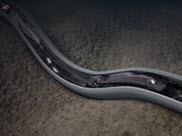Some of the most severe operational hazards are associated with the transportation of fluids. When oil, water, and gas simultaneously flow in a well or pipeline, many problems can arise. These problems may be related to flow instabilities, solids formation that may potentially block the flowpath, and erosion and corrosion that may potentially result in pipeline ruptures.
The Pipesim steady-state multiphase flow simulator offers workflows for both front-end system design and production operations. The Pipesim simulator is frequently used to identify situations that require more detailed transient simulation using the Olga multiphase flow simulator. Such situations may include shut-in, startup, ramp-up, terrain-induced slugging, severe slugging, slug tracking, hydrate kinetics and wellbore cleanup. Together, the Pipesim and Olga simulators offer the most rigorous modeling solution for multiphase flow systems.
Typical flow assurance applications:
Pipeline and facility sizing
- Size pipelines to minimize backpressure while maintaining stable flow within the maximum allowable operating pressure (MAOP).
- Size pumps, compressors, and multiphase boosters to meet target rates.
- Examine system-design layout options and operating parameters for a range of inputs.
- Size separation equipment and slug catchers to manage liquids associated with pigging, ramp-up surges, and hydrodynamic slugging volumes.
- Design and optimize pipelines and equipment such as pumps, compressors, and multiphase boosters to maximize production and capital investment.
Well performance
- Perform nodal analysis and diagnose liquid loading or lift requirements.
- Design artificial lift systems (e.g., rod pumps, progressing cavity pumps, ESPs, and gas lift) and compare their relative benefits.
- Optimize production through intelligent completions by modeling downhole flow control valves or other downhole equipment, such as chokes, subsurface safety valves, separators, and chemical injectors.
- Optimize the completion design by considering skin effects on horizontal well length and tubing or casing size.
- Model multilaterals or wells with multiple layers and crossflow.
Liquids managements
- Identify the risk for severe riser slugging.
- Account for emulsion formation.
- Assess the operational risk from the deposition of wax along flowlines over time.
Integrity
- Identify locations prone to corrosion and predict CO2 corrosion rates.
- Model erosion using the API 14E and Salama methods.
- Manage pipeline integrity with erosion and corrosion prediction.
- Accurately characterize fluid behavior with a wide variety of black-oil and compositional fluid models.
Solids management
- Identify the risks of potential solids formation including wax, hydrates, asphaltenes, and scales.
- Assess the risk from deposition of wax along flowlines over time.
- Determine the amount of methanol to inject to avoid hydrate formation.
- Calculate optimal burial depth and insulation requirements for pipelines.

